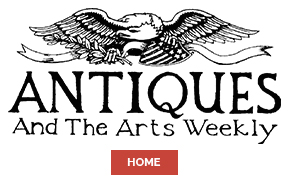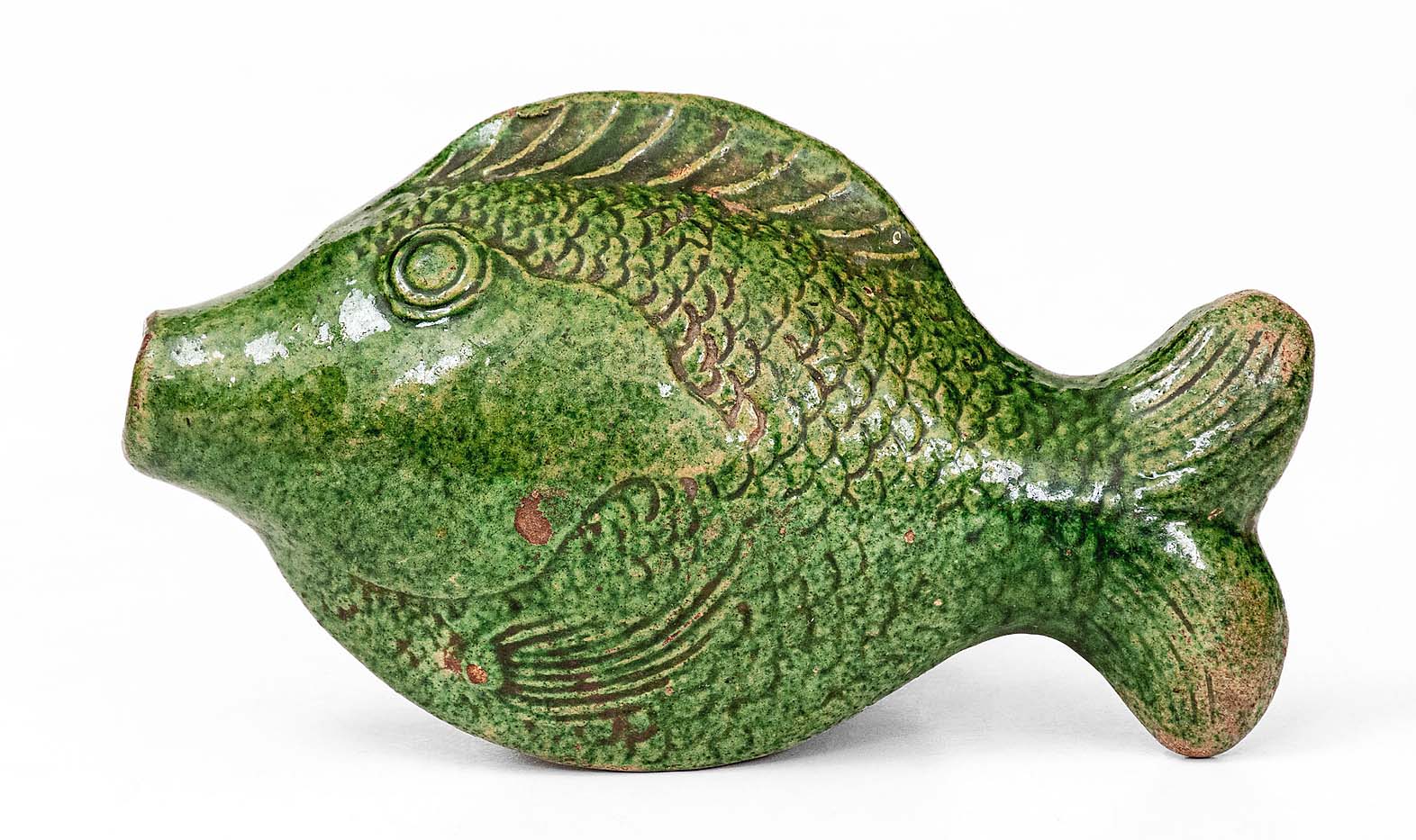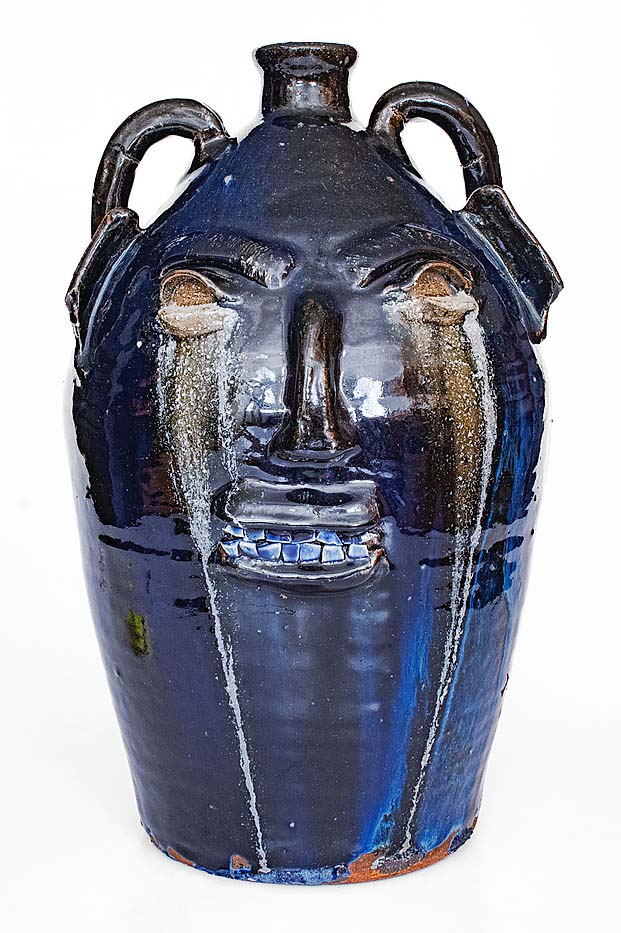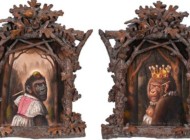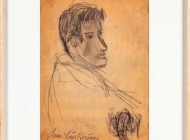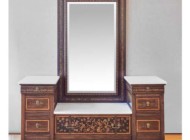
At $72,000, the sale was led by this circa 1855 five-gallon crock by J. & E. Norton, Bennington, Vt., that featured a reclining stag, a house, trees and shrubbery ($10/20,000).
Review by Carly Timpson
SPARKS, MD. — Crocker Farm’s Summer 2025 auction of American stoneware and redware was conducted from July 30 through August 9. With 570 lots offered and only one passing, the sale realized $1,159,020, and Mark Zipp said “It went great. There were some strong prices and we were very happy with the results. All of the best lots did well, and there were many that overperformed compared to their estimates.”
Finishing on top was a five-gallon J. & E. Norton stoneware crock featuring an image of a deer reclining on top of a hill in front of a house. The circa 1855 cylindrical crock was stamped “J. & E. Norton / Bennington, Vt” and it was decorated with a slip-trailed design of a spotted stag, a house, shrubbery and trees. From the James Chebalo collection, “This work’s large size and combination of an array of desirable Norton design elements place it among the best Norton pieces with single deer decoration that we have ever offered,” according to the auction catalog. The 13-inch-high crock rose well beyond its $10/20,000 estimate, ultimately selling to an advanced folk art collector for $72,000. Zipp added, “The Norton piece speaks to the strength of that Northeast decorative market. A lot of buyers are looking for great decoration, and the Northeast has the best. This one was a very striking design, great size and was in very nice condition.”

This large (15¼ inches high) alkaline-glazed stoneware face jar from the George P. Seigler Pottery, Shaw’s Creek, Edgefield District, S.C., circa 1870-80, was recently discovered in the Northeast and sold for $66,000 ($30/50,000).
As to be expected, the sale included several notable face jugs. Taking top prize in the category was a large alkaline-glazed example from the George P. Seigler Pottery in Edgefield District, S.C. This vessel was recently discovered in the Northeast and it sold to collector and scholar Rob Hunter for $66,000. Zipp reported, “It was a great piece. The size was important — it was incredibly large — and it had an impressed maker’s mark, which makes it one of only a few signed face jugs. Interestingly, the mark was actually a bit later than a lot of these jugs are dated to, so the discovery of this one brought a lot of new scholarship or understanding… perhaps some of the others were actually dated too early…” The maker’s mark on this jug, “G.P. Seigler, Trenton, S.C.,” indicated that it was made circa 1870-80 while many of the others were reported to be from the 1850s or 60s.
A full write-up about this jug and others like it can be found in the auction catalog, which also included the following statement: “A combination of several attributes, including size, maker’s mark, quality of modeling, form and glaze, place this jar among the greatest American ceramic face vessels in existence. This exciting discovery not only broadens our understanding of Edgefield’s stoneware legacy, but significantly advances our knowledge of the region’s captivating and enigmatic face vessels, and the much-studied role of African-American potters in their creation. Additionally, this jar highlights a guild of newly-freed Black potters working in Reconstruction-Era Edgefield District establishing their own identities as craftspeople.”

A new record was set for Edwin Meaders with the $12,000 sale of this King Tut face jug from 1994, Cleveland, Ga., 9¾ inches high ($2,5/3,500).
Other face jugs that sold well include a much smaller one from Edgefield District, probably made at the Thomas J. Davies pottery in the third quarter of the Nineteenth Century. This example, at only 5 inches high, was covered in a mottled olive alkaline glaze, barring the teeth and eyes, and it sold for $19,200, nearly reaching the top of its $20,000 high estimate. Of course, more contemporary face jugs from the Meaders family of Cleveland, Ga., were included in this sale. Earning the top price of $22,800 was one by the family patriarch, Cheever Meaders. Works by Cheever, the son of Meaders Pottery founder John Milton Meaders and the father of potters Lanier, John, Edwin and Reggie, are much less common, and this mid Twentieth Century example sold to a major collector of Meaders pottery for what Zipp called “a respectable price.”
Edwin Meaders created several distinct named series of face jugs, one being King Tut, an example of which was included in this sale and set a record-breaking price for Edwin at $12,000, more than 3 times its high estimate. Zipp shared, “Edwin Meaders is really well known for his blue face jugs. There were some variations he did and one of them was the King Tut jug and there are only a few left. For this one, he added red and made it very interesting. This is the only King Tut jug we’ve sold. It was inscribed ‘#8,’ but we’re not sure how many he made. It was very expressive, very colorful. I haven’t seen another example sell. It’s just a variation on a style that is very colorful and very rare. We’ve been seeing great prices for Meader pottery and the collectors are all over the place, not just regional.”
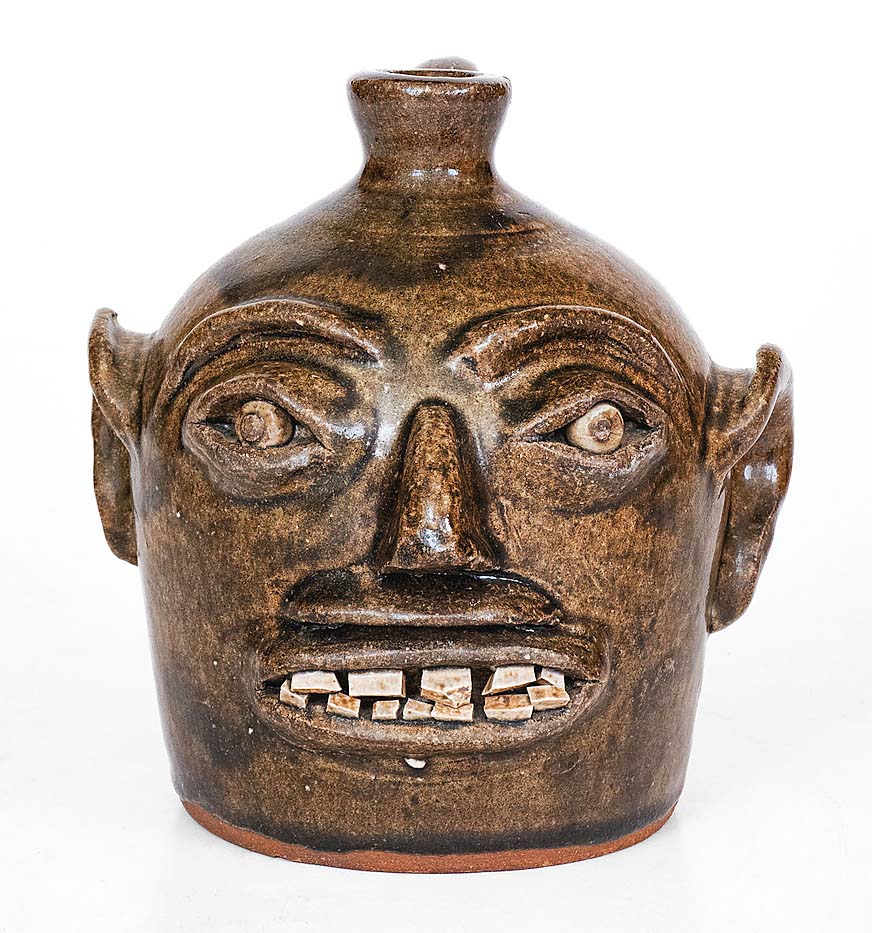
Stamped “H.F. Reinhardt / Vale, N.C.,” this alkaline-glazed stoneware face jug from the second quarter of the Twentieth Century, 7-3/8 inches high, set a record for Harvey Reinhardt at $15,600 ($3/5,000).
Two other face jugs set records for their makers: An alkaline-glazed jug by Harvey Reinhardt, stamped “H.F. Reinhardt / Vale, N.C.,” from the second quarter of the Twentieth Century brought $15,600 against a $5,000 high estimate, and a large early-period weeping cobalt jug by Burlon B. Craig, stamped “B.B. Craig / Vale, N.C.,” set the new mark at $11,400 against a $4,000 high estimate. “Its exciting to see these Twentieth Century masters getting recognized and seeing the change in the market,” remarked Zipp.
Another category that showed exceptional results was that of pottery out of Western Pennsylvania. “The sale showed strength in the Western Pennsylvania pottery market as a whole. There is broad interest in it because it is so decorative, and in this sale we had one of the best selections of higher-end Western Pennsylvania stoneware that has come to auction in quite some time, so it did very well.”
The top price for a Western Pennsylvania piece was achieved by a pitcher with Federal eagle motifs, made by William Porter in Pleasantville, Penn. Earning $54,000, this circa 1830 pitcher set a record for any piece of Venango County stoneware and it had sold by Crocker Farm previously in 2009, making just $27,600 at that time.
Zipp also shared that Rice’s Landing, Penn.-maker Isaac Hewitt, Jr’s, 20-gallon jar, circa 1875, “sold in October 2017 for $18,880, and then this time around it made $42,000 — quite a big jump!” This was a record for Hewitt, and it led a selection of what Zipp identified as monumental, or oversized, jars that were almost exclusive to the region. “There were a great deal of large sized vessels made out of Western Pennsylvania. Very highly skilled potters in Rice’s Landing called themselves ‘big-ware potters.’ You can’t just go anywhere and find guys who could throw these large pieces. Collectors really like them — they make a statement because they’re so big. They’re pretty distinctive to the region because they’re so large. When you start to get into 10-plus gallons, it really affects the value of the pottery.”

The record for any Isaac Hewitt, Jr, piece was set by this circa 1875 20-gallon jar stenciled “Excelsior Works / Isaac Hewitt, Jr. / Rices Landing, PA.” Measuring 18½ inches high by 20½ inches in diameter, the monumental jar was bid to $42,000 ($10/20,000).
Others in the category included several new discoveries and fresh-to-market pieces, such as a 10-gallon jar stamped “Boughner / Greensboro / PA.” This circa 1865 example was notable not only for its size but also because the stamp was missing the “A & W” before the maker’s name. Zipp explained, “The Boughner family pottery is very desirable, and this was the highest price for any piece made by them. The early works by the brothers, Alex and William, were stamped with both of their initials, but this one had the initials removed, likely right after Alexander took sole ownership of the pottery.” The record price earned by this piece was $24,000, double its high estimate.
A circa 1870 10-gallon stenciled “Hamilton & Jones / Greensboro / Greene Co. Pa” also featured stenciled stars and eagle decorations. This example, which recently surfaced in Virginia, having descended in the family of the consignor, brought $19,200.
Redware also saw strong results, with a flask out of Alamance County, N.C., making the third-highest price in the sale at $57,000, which was a record for any flask made there. Attributed to the Loy or Albright families, this late Eighteenth Century flask had a flattened circular body and was detailed with a two-colored 16-point star on either side. The catalog noted that “This outstanding flask combines high decorative appeal in its bold, regional slip decoration with extreme rarity, being only the second example of this form documented in Alamance County redware production. The other example, glazed dark-brown with three-color slip decoration, is owned by Old Salem Museum and Gardens.” An advanced Southern collector took this two-color example home with them.
Prices quoted include the buyer’s premium as reported by the auction house. For information, www.crockerfarm.com or 410-472-2016.
